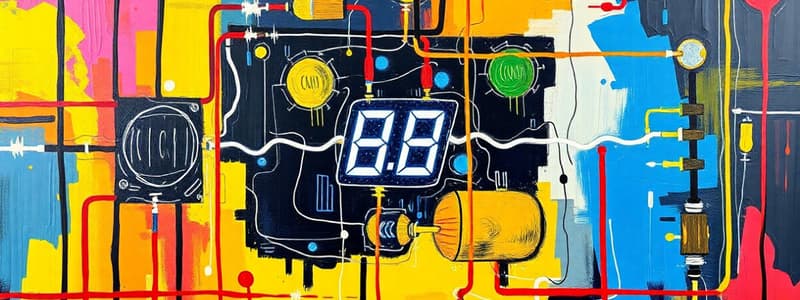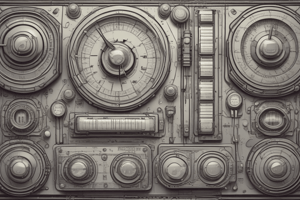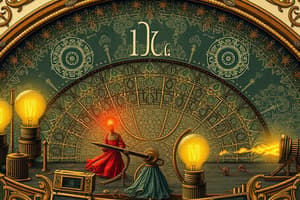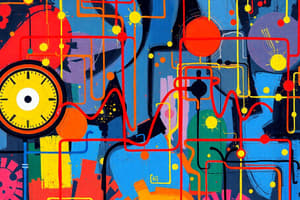Podcast
Questions and Answers
What is the defining characteristic of direct current (d.c.)?
What is the defining characteristic of direct current (d.c.)?
- Change of direction over time
- Stable voltage levels regardless of load
- Movement of charge in both directions
- Movement of charge in one direction only (correct)
Which statement correctly describes alternating current (a.c.)?
Which statement correctly describes alternating current (a.c.)?
- Voltage fluctuates smoothly without interruption
- The direction of charge movement reverses periodically (correct)
- It is primarily used in batteries and cells
- Charge flows evenly in one direction
What are the typical voltage and frequency of domestic supply in the UK?
What are the typical voltage and frequency of domestic supply in the UK?
- 240 V and 60 Hz
- 230 V and 50 Hz (correct)
- 120 V and 60 Hz
- 110 V and 50 Hz
How do the live and neutral wires differ in function?
How do the live and neutral wires differ in function?
Which statement accurately describes the role of electrical appliances in terms of energy storage?
Which statement accurately describes the role of electrical appliances in terms of energy storage?
What is a common voltage level for a typical domestic electrical appliance?
What is a common voltage level for a typical domestic electrical appliance?
What feature distinguishes alternating current from direct current in practical applications?
What feature distinguishes alternating current from direct current in practical applications?
Which is NOT a characteristic of direct current (d.c.)?
Which is NOT a characteristic of direct current (d.c.)?
During the operation of an a.c. electrical system, what happens to the direction of current?
During the operation of an a.c. electrical system, what happens to the direction of current?
What is the primary reason for the use of a.c. in domestic supplies?
What is the primary reason for the use of a.c. in domestic supplies?
What would likely occur if an appliance designed for a.c. was connected to a d.c. source?
What would likely occur if an appliance designed for a.c. was connected to a d.c. source?
In terms of energy efficiency, which is a typical behavior of direct current systems?
In terms of energy efficiency, which is a typical behavior of direct current systems?
What factor influences the choice between using d.c. and a.c. in electrical systems?
What factor influences the choice between using d.c. and a.c. in electrical systems?
Which statement best describes the relationship between electrical appliances' power ratings and energy consumption?
Which statement best describes the relationship between electrical appliances' power ratings and energy consumption?
What impacts the current in a circuit when resistance changes?
What impacts the current in a circuit when resistance changes?
Which equation best defines the relationship between voltage, current, and resistance?
Which equation best defines the relationship between voltage, current, and resistance?
How does electrical energy dissipate when a current operates against resistance?
How does electrical energy dissipate when a current operates against resistance?
What occurs to the power in an electric circuit if both current and voltage increase?
What occurs to the power in an electric circuit if both current and voltage increase?
What effect does increasing the resistance have on the energy transferred in a circuit with a constant potential difference?
What effect does increasing the resistance have on the energy transferred in a circuit with a constant potential difference?
Which materials typically provide higher resistance in electrical circuits?
Which materials typically provide higher resistance in electrical circuits?
What is the unit of power in electrical terms?
What is the unit of power in electrical terms?
Which factor does not directly influence the total resistance in a circuit?
Which factor does not directly influence the total resistance in a circuit?
What relationship exists when an electrical current flows through a conductor at a steady temperature?
What relationship exists when an electrical current flows through a conductor at a steady temperature?
How can energy be calculated for a circuit with known current, voltage, and time?
How can energy be calculated for a circuit with known current, voltage, and time?
In which configuration is current equal in all branches of the circuit?
In which configuration is current equal in all branches of the circuit?
Which of the following devices typically uses a variable resistor?
Which of the following devices typically uses a variable resistor?
Which property allows a conductor to maintain a constant potential difference despite variations in load?
Which property allows a conductor to maintain a constant potential difference despite variations in load?
How can the energy transfer be maximized in a circuit?
How can the energy transfer be maximized in a circuit?
Flashcards
Electric circuits
Electric circuits
Paths for electric current to flow.
Current and potential difference
Current and potential difference
Flow of electric charge and force driving the current.
Current, charge, energy
Current, charge, energy
Flow of electric charge carries energy.
Resistance formula
Resistance formula
Signup and view all the flashcards
Changing resistance
Changing resistance
Signup and view all the flashcards
Variable resistor
Variable resistor
Signup and view all the flashcards
Potential difference (V)
Potential difference (V)
Signup and view all the flashcards
Current (I)
Current (I)
Signup and view all the flashcards
Resistance (R)
Resistance (R)
Signup and view all the flashcards
Energy transferred
Energy transferred
Signup and view all the flashcards
Energy transfer equation
Energy transfer equation
Signup and view all the flashcards
Power (P)
Power (P)
Signup and view all the flashcards
Power equation (1)
Power equation (1)
Signup and view all the flashcards
Power equation (2)
Power equation (2)
Signup and view all the flashcards
Power equation (3)
Power equation (3)
Signup and view all the flashcards
Direct Current (DC)
Direct Current (DC)
Signup and view all the flashcards
Alternating Current (AC)
Alternating Current (AC)
Signup and view all the flashcards
Mains Voltage
Mains Voltage
Signup and view all the flashcards
Mains Frequency
Mains Frequency
Signup and view all the flashcards
Voltage (UK)
Voltage (UK)
Signup and view all the flashcards
Electrical Appliances
Electrical Appliances
Signup and view all the flashcards
Power Rating
Power Rating
Signup and view all the flashcards
Stored Energy
Stored Energy
Signup and view all the flashcards
Live Wire
Live Wire
Signup and view all the flashcards
Neutral Wire
Neutral Wire
Signup and view all the flashcards
Electric Current
Electric Current
Signup and view all the flashcards
Direct Current
Direct Current
Signup and view all the flashcards
Alternating Current
Alternating Current
Signup and view all the flashcards
Energy Conversion
Energy Conversion
Signup and view all the flashcards
Power
Power
Signup and view all the flashcards
Electrical Circuit
Electrical Circuit
Signup and view all the flashcards
Study Notes
CP9 Electricity and Circuits
- CP9a Electric Circuits:
- Atoms are composed of protons, neutrons, and electrons.
- Electrical components have recognized circuit symbols (cells, batteries, switches, voltmeters, ammeters, lamps).
- Circuit diagrams use standard conventions (positive and negative terminals).
- Identical lamps in series have different brightness than those in parallel circuits.
- The brightness of lamps and the effect of different numbers of identical lamps, cells, and switches in series and parallels circuits can be described and explained.
CP9b Current and Potential Difference
- Measuring Voltage: Methods of measuring voltage are described.
- Potential Difference: The term "potential difference" is defined.
- Measuring Current: Methods of measuring current are described.
- Electric Current: The conditions necessary to produce an electric current are described (complete circuit and voltage source).
- Current at Junction: The behavior of current at a junction is described.
CP9c Current, Charge, and Energy
- Potential Difference, Charge, and Energy Transfer: The link between voltage, charge flow, and energy transfer are explained. The unit of potential difference (volt) is defined in terms of energy and charge (joule per coulomb).
- Energy Transfer Equation: The equation for calculating energy transferred, charge flow, and potential difference (E = Q × V) is recalled and used.
- Current and Electric Charge: Electric current and electrical charge are related.
- Electric Current in Metals: Electric current in metals is explained in terms of electrons.
- Charge Flow Equation: The equation for calculating charge, current, and time (Q = I × t) is recalled and used.
CP9d Resistance
- Resistance and Current: How changing resistance affects current, using a variable resistor, is explained.
- Potential Difference = Current × Resistance: Using the equation V = I × R
- Resistors in Series and Parallel: Why resistance increases in series circuits and decreases in parallel circuits is explained.
- Calculations in Circuits: Calculate currents, potential differences, and resistances in series circuits described.
- Circuit Design: The design and construction of circuits for testing and measuring are explained.
CP9e More About Resistance
- Filament Lamps: Variation of current with potential difference for filament lamps is explained in relation to resistance.
- Diodes: Resistance in diodes is described in relation to light intensity.
- Thermistors: How thermistor resistance changes with temperature change (negative temperature coefficient) is described.
- LDRs: How light-dependent resistors' resistance varies with light intensity is described.
- Circuit Construction: Electrical circuits can be used to observe resistance variations in different devices like filament lamps, diodes, thermistors, and LDRs.
CP9f Transferring Energy
- Energy Transfer in Resistors: When current flows through a resistor, energy is transferred to heat. This is explained.
- Dissipation of Electrical Energy: Electrical energy transfers to thermal energy in surroundings when electrical current does work against resistance.
- Energy Transfer in Circuits: Energy transfer in a circuit is explained as the result of electron collisions and lattice ions.
- Reducing Energy Transfer: Ways of reducing unwanted energy transfer throughout low resistance wires are explained.
- Heating Effect of Electricity: Advantages and disadvantages of the heating effect of electric current.
- Energy Transfer Equation: An equation is provided to calculate energy transferred (E=I×VxT).
CP9g Power
- Power Definition: Power is defined as energy transferred per second, in watts.
- Power Equation: Recall and use the equation P = E/t for power.
- Power Relationship: How power transfer relates to circuit potential difference and current. Electrical power equations (P = I × V and P = I² × R) are recalled and used.
CP9h Transferring Energy by Electricity
- Domestic Devices: How energy transfers in different domestic devices (e.g., motors, heating devices) is described.
- Direct and Alternating Voltage: Difference between direct and alternating voltage is explained.
- Direct Current (DC): Direct current in terms of charge movement is described, noting that cells and batteries supply DC.
- Alternating Current (AC): Alternating current is defined as charge changing direction.
- UK Domestic Supply: Characteristics of the UK domestic alternating current supply (50 Hz, 230 V) are recalled.
- Appliance Power Ratings: How appliance power ratings relate to energy use in domestic settings.
CP9i Electrical Safety
- Live and Neutral Wires: Difference in function between live and neutral mains wires is explained.
- Earth Wire: The function of an earth wire is explained, and the importance of fuses or circuit breakers in safety is explained.
- Wiring Safety: Why switches and fuses should be connected in the live wire of a domestic circuit is explained.
- Potential Differences: Potential differences between live, neutral, and earth mains wires are recalled.
- Live and Earth Connection Dangers: The dangers of providing any connection between the live wire and earth are explained.
Studying That Suits You
Use AI to generate personalized quizzes and flashcards to suit your learning preferences.





